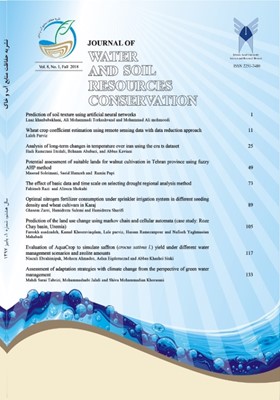-
-
List of Articles
-
Open Access Article
1 - Prediction of soil texture using artificial neural networks
علی محمدی ترکاشوند Elnaz Khanbabakhani Mohammad Ali Mahmoodi -
Open Access Article
2 - Estimating wheat crop coefficient using remote sensing data and data reduction approach
Laleh Parviz -
Open Access Article
3 - Analysis of long-term changes in temperature over iran using the cru ts dataset
هادی رمضانی Behnam Ababaei Abbas Kaviani -
Open Access Article
4 - Potential assessment of suitable lands for walnut cultivation in Tehran province using fuzzy AHP method
Masoud Soleimani Saeid Hamzeh Ramin Papi -
Open Access Article
5 - The effect of basic data and time scale on selecting drought regional analysis method
Fahimeh Razi Alireza Shokoohi -
Open Access Article
6 - Optimal nitrogen fertilizer consumption under sprinkler irrigation system in different seeding density and wheat cultivars in Karaj
Ghasem Zarei Hamidreza Salemi Hamidreza ُSharifi -
Open Access Article
7 - Prediction of the land use change using markov chain and cellular automata (case study: Roze Chay basin, Uremia)
Farrokh Asadzadeh Kamal Khosravi Aqdam Laleh Parviz Hassan Ramazanpour Nafiseh Yaghmaeian Mahabadi -
Open Access Article
8 - Evaluation of AquaCrop to simulate saffron (crocus sativus l.) yield under different water management scenarios and zeolite amounts
Niazali Ebrahimipak Mohsen Ahmadee Aslan Egdernezhad Abbas Khashei Suiki -
Open Access Article
9 - Assessment of adaptation strategies with climate change from the perspective of green water management
Mahdi Sarai Tabrizi Mohammad Nabi Jalali Shiva Mohammadian khorasani
-
The rights to this website are owned by the Raimag Press Management System.
Copyright © 2021-2025







